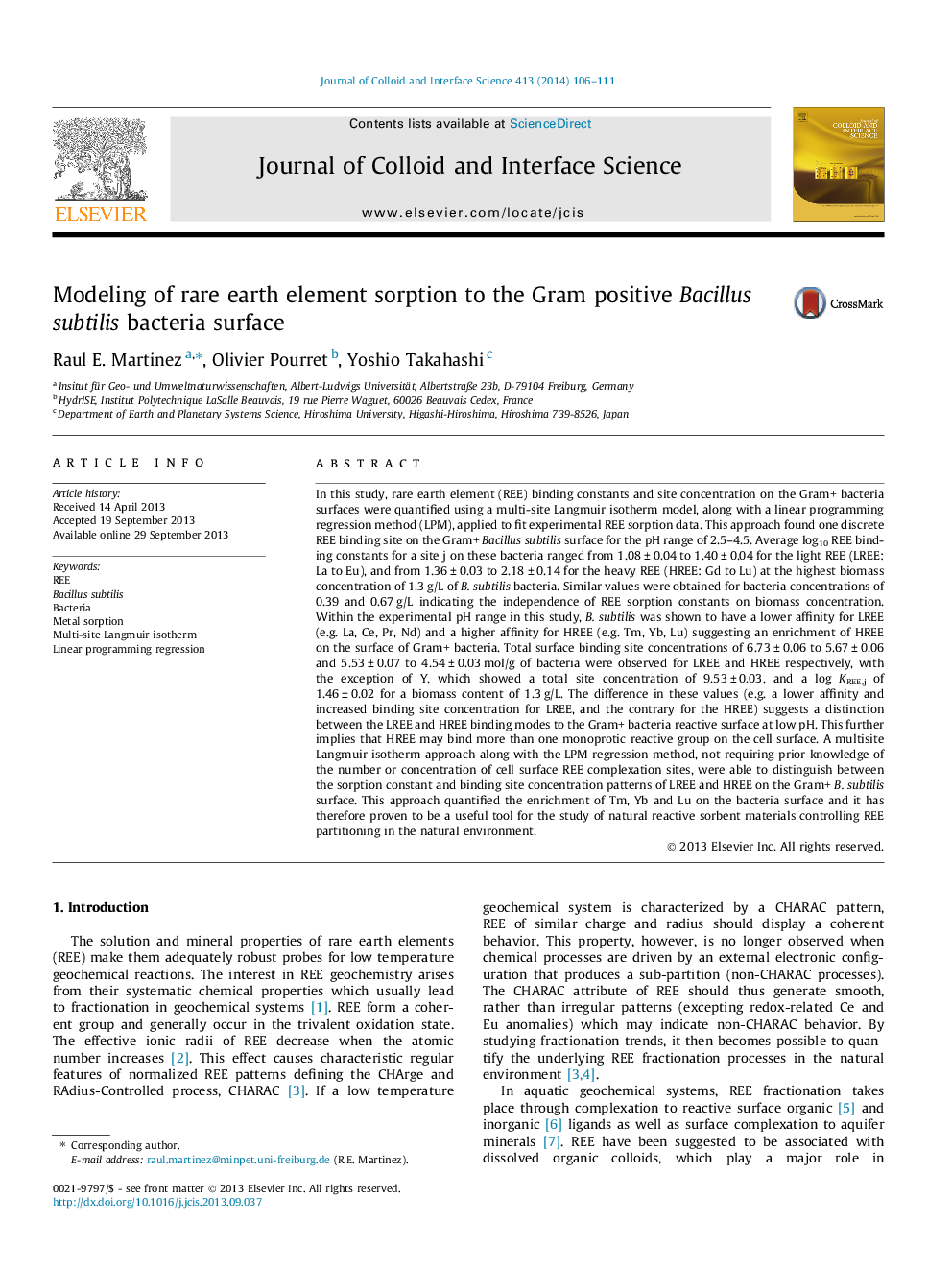| کد مقاله | کد نشریه | سال انتشار | مقاله انگلیسی | نسخه تمام متن |
|---|---|---|---|---|
| 607494 | 1454582 | 2014 | 6 صفحه PDF | دانلود رایگان |

• A single binding site was found for REE on Bacillus subtilis at low pH.
• Modeling of sorption data by LPM shows REE enrichment on bacteria.
• HREE (Tm, Yb, Lu) show strong enrichment pattern on B. subtilis.
• LPM modeling suggests carboxylic groups for REE binding on bacteria.
In this study, rare earth element (REE) binding constants and site concentration on the Gram+ bacteria surfaces were quantified using a multi-site Langmuir isotherm model, along with a linear programming regression method (LPM), applied to fit experimental REE sorption data. This approach found one discrete REE binding site on the Gram+ Bacillus subtilis surface for the pH range of 2.5–4.5. Average log10 REE binding constants for a site j on these bacteria ranged from 1.08 ± 0.04 to 1.40 ± 0.04 for the light REE (LREE: La to Eu), and from 1.36 ± 0.03 to 2.18 ± 0.14 for the heavy REE (HREE: Gd to Lu) at the highest biomass concentration of 1.3 g/L of B. subtilis bacteria. Similar values were obtained for bacteria concentrations of 0.39 and 0.67 g/L indicating the independence of REE sorption constants on biomass concentration. Within the experimental pH range in this study, B. subtilis was shown to have a lower affinity for LREE (e.g. La, Ce, Pr, Nd) and a higher affinity for HREE (e.g. Tm, Yb, Lu) suggesting an enrichment of HREE on the surface of Gram+ bacteria. Total surface binding site concentrations of 6.73 ± 0.06 to 5.67 ± 0.06 and 5.53 ± 0.07 to 4.54 ± 0.03 mol/g of bacteria were observed for LREE and HREE respectively, with the exception of Y, which showed a total site concentration of 9.53 ± 0.03, and a log KREE,j of 1.46 ± 0.02 for a biomass content of 1.3 g/L. The difference in these values (e.g. a lower affinity and increased binding site concentration for LREE, and the contrary for the HREE) suggests a distinction between the LREE and HREE binding modes to the Gram+ bacteria reactive surface at low pH. This further implies that HREE may bind more than one monoprotic reactive group on the cell surface. A multisite Langmuir isotherm approach along with the LPM regression method, not requiring prior knowledge of the number or concentration of cell surface REE complexation sites, were able to distinguish between the sorption constant and binding site concentration patterns of LREE and HREE on the Gram+ B. subtilis surface. This approach quantified the enrichment of Tm, Yb and Lu on the bacteria surface and it has therefore proven to be a useful tool for the study of natural reactive sorbent materials controlling REE partitioning in the natural environment.
Figure optionsDownload high-quality image (45 K)Download as PowerPoint slide
Journal: Journal of Colloid and Interface Science - Volume 413, 1 January 2014, Pages 106–111